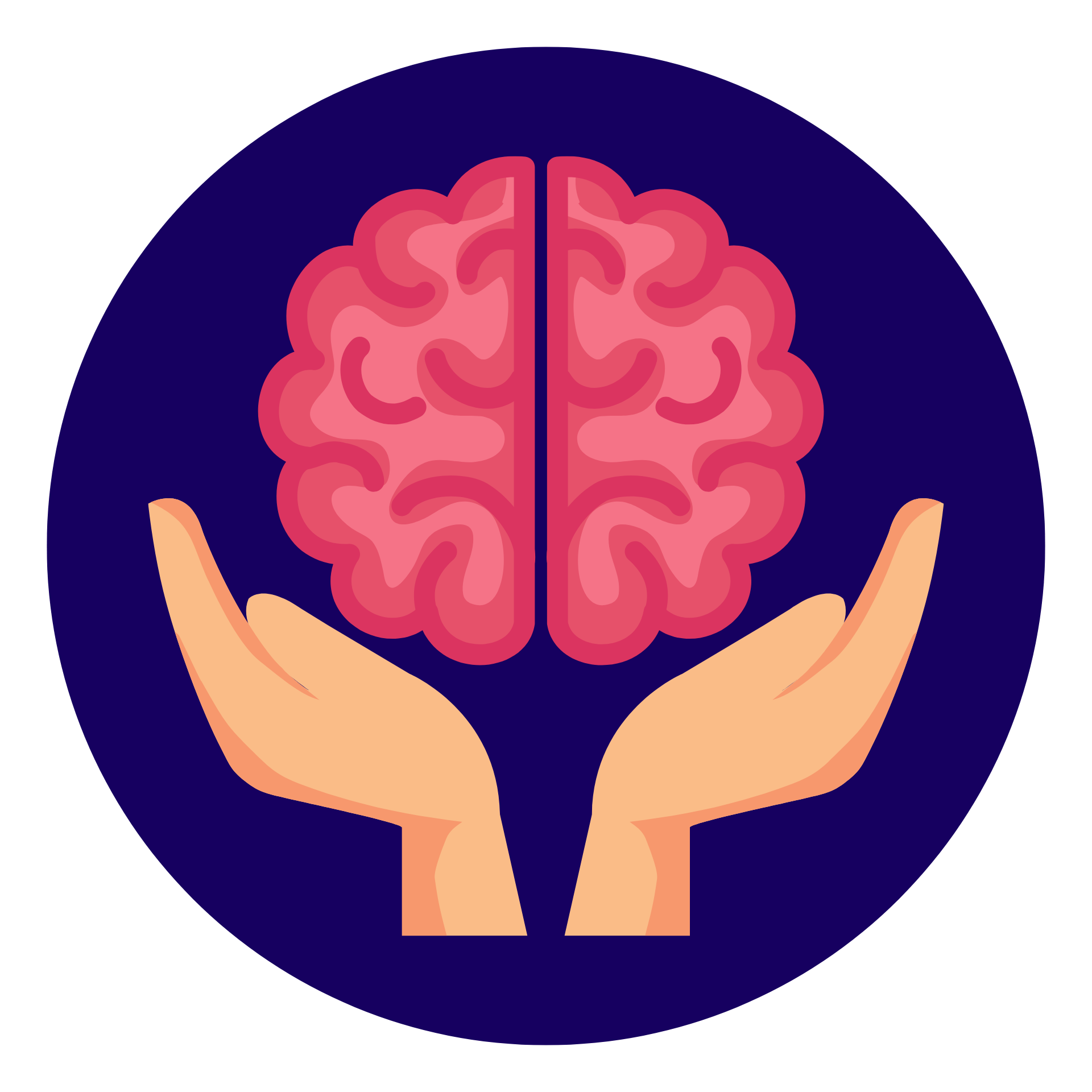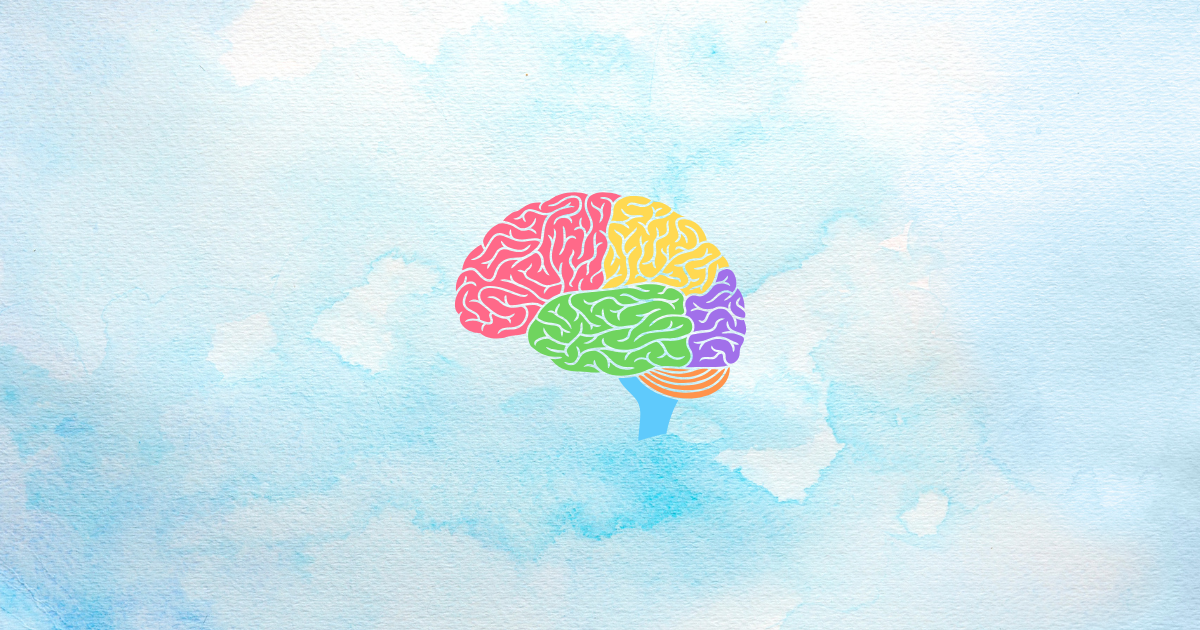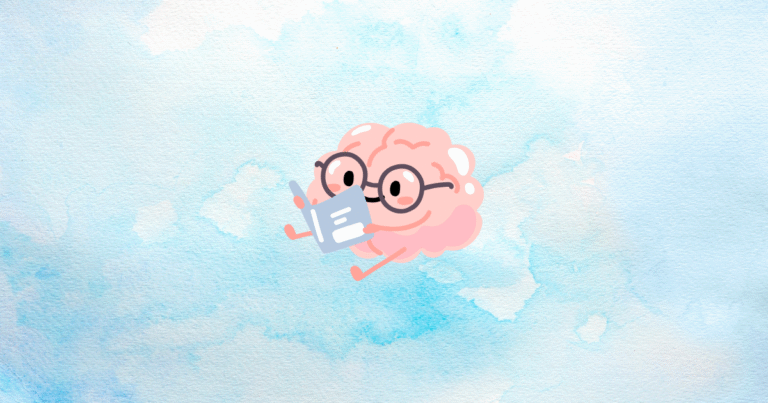Have you ever seen customers fill their carts with products and then disappear just when you think you’ve sealed the deal? It can feel like a mystery. But the truth lies in how the human brain reacts during checkout. In this article, we’ll look at the science behind those last-second exits and learn how to guide shoppers toward that final click. By the end, you’ll have fresh ideas to keep buyers on board and ready to complete their purchases. Ready to begin? Let’s jump in.
Understanding the Neuroscience of Checkout Abandonment
This section uncovers how different parts of the brain guide purchase decisions, handle mental workload, and respond to trust signals. We’ll also touch on how emotions and decision fatigue can lead to cart abandonment. By the end, you’ll see why checkout isn’t just about a form—it’s about tapping into how the mind works.
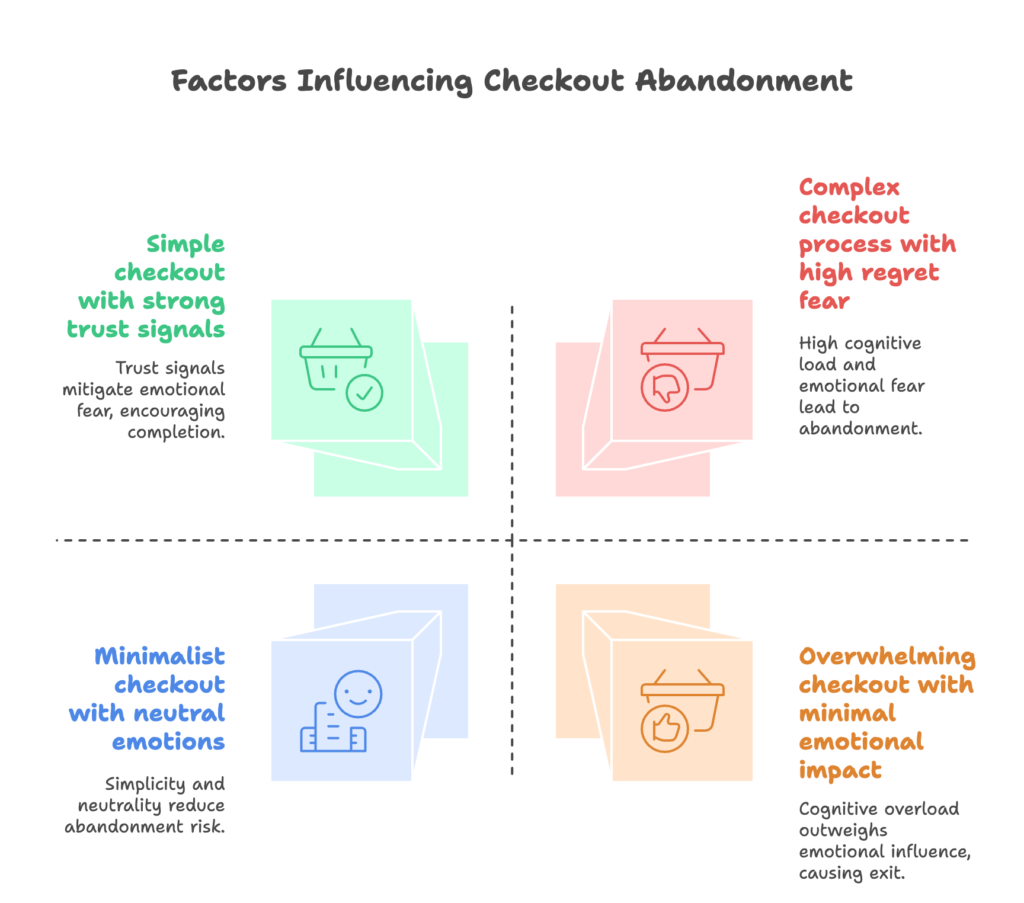
The Neurological Basis of Purchase Decisions
When a shopper lands on your store, various regions of the brain handle cost analysis and reward anticipation. The reward center gets excited about the product, while logical areas weigh whether it’s a smart purchase. If these regions clash, shoppers may leave their carts behind. Understanding this balance can help you create a smooth path that calms doubts and encourages follow-through.
Cognitive Load Theory and Its Impact on Checkout Completion
Cognitive load refers to the mental energy spent processing information. A checkout with too many steps or confusing details increases that load. Shoppers become mentally drained, and they bail. By reducing the number of fields or displaying progress clearly, you help the brain stay focused on completing the purchase.
The Psychology of Trust and Security in Digital Transactions
The human brain quickly looks for signals of safety in online checkouts. Elements like security badges and trusted payment icons reassure anxious minds. Without these cues, the brain senses risk. That risk can be enough to push people away, so offering strong proof of reliability can help break down those mental barriers.
Emotional Triggers in the Abandonment Process
Emotions often sneak in when we’re about to buy. Excitement and fear can clash. If the fear of regret outweighs the thrill of getting a new item, the shopper may hesitate. Crafting a checkout that keeps positive feelings high and concerns low can stop that abrupt exit.
The Neuroscience of Decision Fatigue During Checkout
Every choice we make—colors, sizes, shipping speeds—uses a bit of our mental fuel. By the time we reach the checkout page, we can be tired of choosing. This is decision fatigue. Keeping the checkout straightforward helps preserve mental energy for the final “Yes, I’m buying!” moment.
We’ve explored how the brain processes trust, mental load, and choices. Next, we’ll look at the key obstacles that often spark a shopper’s decision to leave. Let’s see what’s really blocking those conversions.
Core Neurological Barriers in the Checkout Process
Here, we focus on the brain’s response to sudden costs, confusing design, and trust signals. By understanding these barriers, you can address them head-on. After this chapter, you’ll recognize why some shoppers vanish without warning—and how to keep them engaged.
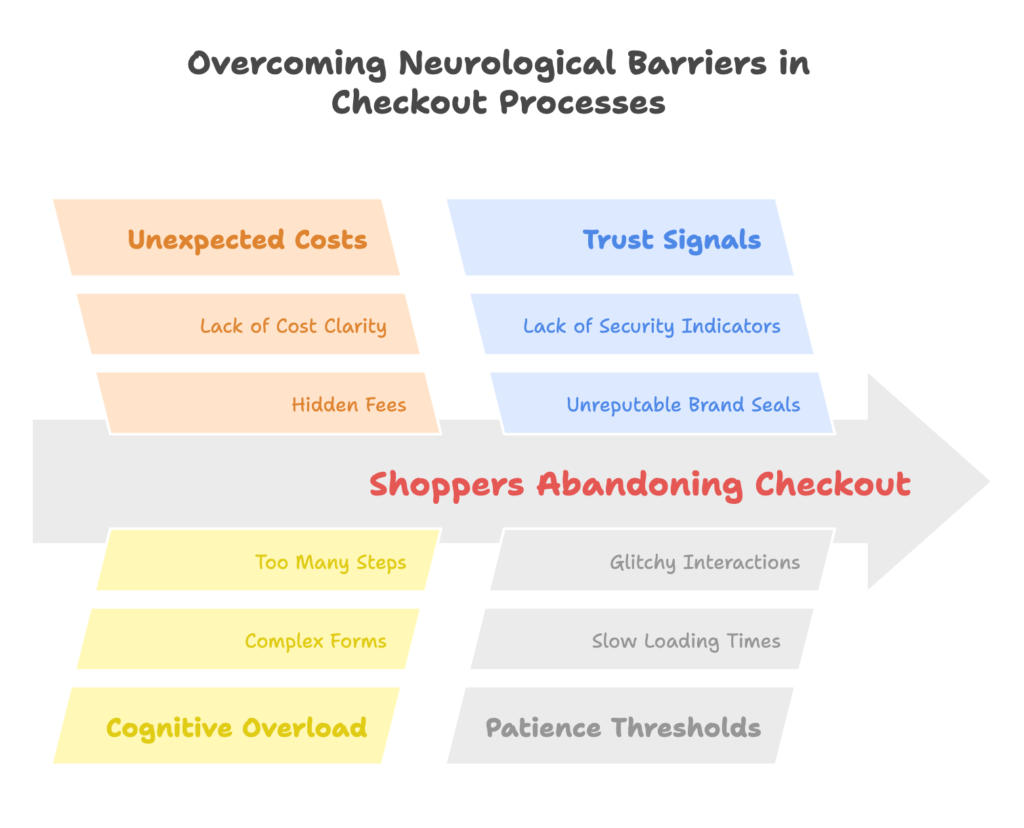
Unexpected Costs and the Brain’s Loss Aversion Response
When hidden fees pop up, the brain’s natural aversion to loss flares. The extra cost feels like a threat, and the reward center rapidly cools down. By being clear about costs from the start, you reduce those defensive reactions and lessen abandonment rates.
Cognitive Overload from Complex Checkout Processes
Multiple form fields, extra pages, and endless details overwhelm the brain. This leads to overload, where the mental effort feels too high. Streamlined checkouts with fewer fields and clear progress markers keep the mind calm and on track to finish the purchase.
Trust Signals and the Amygdala’s Security Assessment
The amygdala helps detect threats. In online shopping, it looks for data encryption, reputable brand seals, and secure payment methods. If anything feels off, the amygdala signals “danger” and the shopper flees. Placing visible trust markers can lower that alarm.
The Neuroscience of Patience Thresholds in Digital Experiences
Patience is not unlimited. Slow-loading pages or glitchy buttons test a shopper’s willingness to wait. The mind quickly checks if the wait is worth the reward. To keep people around, fast performance and smooth actions are essential.
Dopamine Disruption: When Reward Anticipation Breaks Down
The promise of a new product triggers dopamine, the chemical linked to anticipation. But sudden hassles—like random shipping costs—can break that flow. Keeping checkout straightforward ensures dopamine stays high, making shoppers more likely to finalize their purchases.
Now that we’ve seen these brain-based barriers, it’s time to zoom in on one of the biggest culprits: hidden costs. Let’s learn how unexpected fees spark an emotional storm that sends shoppers running.
The Hidden Costs Phenomenon
This chapter spotlights the mental and emotional responses triggered by hidden charges. You’ll see how sudden fees can feel like a personal breach of trust, lighting up the brain’s “loss aversion” alarm. By the end, you’ll have methods to keep unexpected costs from driving customers away.
Neural Responses to Price Shock and Unexpected Fees
Our brains quickly pick up on price jumps. The shock disrupts the positive feelings of shopping. That negative jolt can create a lasting impression, making people leave before they finish checking out.
The Psychological Contract and Perceived Betrayal
When shoppers see a sudden fee, they may feel a sense of betrayal. They expected transparency and got a surprise instead. This emotional response can be powerful enough to override any excitement they had for the product.
Loss Aversion Activation in the Prefrontal Cortex
The prefrontal cortex weighs gains and losses. If a last-minute cost appears, it raises the sense of losing money unfairly. By avoiding such surprises or clearly stating fees early, you reduce this knee-jerk urge to abandon the cart.
Transparency vs. Surprise: Neurological Impact on Trust
Brains respond positively to honesty. If your checkout is straightforward about pricing, the buyer keeps calm. If it suddenly reveals extra charges, trust takes a hit, and the brain signals a warning to leave.
Strategies for Mitigating Negative Neural Responses to Costs
One approach is to show shipping and taxes early in the process. Another is to offer small rewards, like free shipping for orders over a certain amount, which soothes the brain’s loss aversion. Giving a clear breakdown of final costs also helps prevent unpleasant surprises.
We’ve tackled hidden fees and how they affect trust. Next, we’ll look at the mental toll of checkout design and the ways to keep the brain from feeling overloaded.
Cognitive Overload in Checkout Design
This chapter zeroes in on how the mind handles multiple fields, account sign-ups, and multi-page funnels. By cutting down on complexity, you lessen mental strain and keep shoppers happier. After this, you’ll have fresh ways to make your checkout easier on the brain.
Working Memory Limitations and Form Field Fatigue
Our working memory can handle only a handful of items at once. Each extra form field adds mental effort. When that load reaches a tipping point, frustration sets in, and people exit.
Account Creation Requirements and Decision Paralysis
Having to create an account before buying can feel like a chore. It adds steps and choices, potentially causing mental overload. Offering a guest checkout eases that burden, smoothing the buyer’s path.
The Neurological Cost of Multi-Page Checkout Processes
Every new page demands mental energy and time. The brain starts to question if it’s worth continuing. Reducing the number of pages or combining steps can help keep attention locked on finishing the purchase.
Mobile Cognitive Load Considerations
On a mobile screen, distractions multiply. Small keyboards, notifications, and cramped layouts can pile on mental strain. Designing for simplicity on smaller screens can reduce cart abandonment significantly.
Designing for Cognitive Ease and Neural Flow
Clear instructions, minimal fields, and visible progress bars all help the mind move forward. A checkout that flows well keeps the shopper’s brain relaxed and confident, increasing the chance of a completed purchase.
We’ve talked about reducing mental strain. Now, let’s look at another key factor: trust and security signals that calm the brain’s fear of risk.
The Neuroscience of Trust and Security Concerns
This chapter shows why visual markers of safety and familiarity can ease a shopper’s fear. We’ll dig into the role of the amygdala in detecting threats and see how social proof can boost confidence. By the end, you’ll know how to build an online environment that soothes the mind.
Visual Trust Signals and Their Impact on the Brain
Logos from known security providers or payment methods speak directly to the shopper’s sense of safety. The brain sees these markers and feels more at ease. Without them, the fear of fraud grows, driving a desire to leave.
The Amygdala’s Role in Detecting Security Threats
The amygdala constantly scans for danger. Any sign of risk—like unfamiliar payment pages—raises red flags. Showing recognizable brands and certification badges helps keep this alarm system on standby.
Familiarity Bias and Payment Method Preferences
When people see a payment option they know and trust, their brains calm down. Unfamiliar methods spark doubt. Offering popular methods, such as well-known credit cards or digital wallets, can reduce fear and keep the checkout process steady.
Social Proof Elements and Mirror Neuron Activation
Positive reviews and testimonials activate mirror neurons, which help us “feel” what others feel. If others had a good experience, our brains assume we will, too. Displaying real customer stories can boost trust quickly.
Building a Neurologically Reassuring Checkout Environment
Combine all these signals—trust badges, clear branding, strong reviews—to create a safe setting. The shopper’s brain senses fewer threats, making them more likely to complete the purchase.
We’ve seen how security cues calm the mind. Next, let’s focus on speed and patience limits, because even a trusted site can lose sales if it’s slow.
Speed and Patience Thresholds
In this section, we’ll look at how load times, attention spans, and small frustrations can push the brain away from a purchase. By speeding up your store and smoothing out any delays, you keep those impatience triggers in check. Let’s see how to make the experience as quick as possible.
The Neurological Impact of Page Load Times
Slow pages drain mental energy. Shoppers expect instant responses. When the brain senses a delay, it looks for easier options, which could be a competitor’s site. Quicker load times help keep shoppers on your page.
Attention Span Limitations in Digital Environments
Online attention spans can be short. Anything from pop-up messages to slow transitions can break focus. Staying streamlined helps hold attention and reduces the chance of cart abandonment.
Progress Indicators and Perceived Time Dilation
A simple progress bar or step counter gives the brain a sense of movement. It lowers anxiety about how long the process may take. This small addition helps shoppers stay patient when steps are required.
Micro-Frustrations and Their Cumulative Neural Effect
One small annoyance may not be too big. But several can pile up and tip the brain into quitting. Making sure each step works smoothly keeps frustration from building into a final exit.
Optimizing for the Brain’s Temporal Processing
Give feedback fast. Use quick-loading pages and short messages to confirm each step. When the process feels snappy, the brain stays relaxed and willing to move forward.
We’ve highlighted why speed matters. Let’s shift our focus to payment friction and see how removing obstacles in payment options can lead to happier brains and higher conversions.
Payment Friction and Decision Avoidance
This chapter examines what happens in the mind when payment methods are limited or complicated. We’ll look at the concepts of payment pain and spending anxiety. By the end, you’ll see how simpler payment methods improve comfort levels and close more sales.
Limited Payment Options and the Paradox of Choice
Some shoppers want a variety of payment methods, but too many can also cause confusion. Striking a balanced menu of popular choices prevents choice overload while still satisfying different preferences.
The Neuroscience of Payment Pain and Spending Anxiety
Paying can trigger a brief feeling of loss. If the process is awkward or unclear, that negative feeling grows. Transparent pricing and easy payment steps lessen the mental “ouch” of spending.
Card Decline Experiences and Shame Responses
A declined card feels embarrassing. Shoppers might think something is wrong with their finances. This can cause them to abandon the cart altogether. Quick, friendly error messages reduce the sense of shame and encourage a retry.
Mobile Payment Friction Points
Tiny screens and multiple security steps can slow shoppers down on mobile. Integrating mobile-friendly payment tools, like digital wallets, keeps the process comfortable and fast.
Neurologically Optimized Payment Experiences
Speed, clarity, and trusted logos help the brain feel safe. Minimizing steps and offering popular payment methods can keep potential drop-offs to a minimum. The result is a more seamless checkout.
We’ve tackled payment friction. Next, we’ll explore how anxiety after placing an order can start even before the shopper checks out—and how to spot and reduce it.
Post-Purchase Anxiety and Pre-Abandonment Signals
Here, we’ll look at how regret, concerns about returns, and delivery wait times can mess with the brain. Even before paying, shoppers might worry about whether they made the right choice. By the end of this chapter, you’ll understand how to calm these fears early.
Anticipatory Regret and Its Neural Markers
People often imagine the regret they might feel if the product disappoints them. That worry can keep them from hitting “Buy.” Clear product details and easy returns can lower that fear.
Return Policy Concerns and Risk Assessment
A tough or unclear return policy feels risky to the brain. Shoppers may quit if they’re not sure they can return something hassle-free. Highlighting a simple policy makes the purchase feel safer.
Delivery Time Expectations and Delayed Gratification
Waiting days for a product can lower excitement. If shipping is slow or uncertain, the brain may decide it’s not worth it. Providing clear delivery times and updates helps keep reward anticipation alive.
Confirmation Bias in Purchase Justification
Once people decide to buy, they look for reasons to confirm they made a smart move. Positive reviews, user photos, or endorsements help shoppers stay confident, reducing the chance of second thoughts.
Reducing Cognitive Dissonance in the Purchase Process
Encouraging details—like post-purchase emails that celebrate the order—reinforce the choice. This reassurance helps the mind stay at ease instead of wondering if it should have backed out.
We’ve uncovered how post-purchase anxiety can bubble up before checkout. Next, let’s learn how to recover those abandoned carts with tactics based on how memory and attention work.
Implementing Brain-Friendly Checkout Recovery Strategies
In this section, we’ll look at the right timing for abandoned cart emails, retargeting approaches, and incentives that excite reward pathways. We’ll also explore how personalization can tap into familiarity bias. By the end, you’ll have tools to bring shoppers back with a friendly nudge.
Timing and Psychology of Abandoned Cart Emails
The sooner you remind shoppers of their abandoned cart, the fresher it is in their memory. Sending the email too late may lose that sense of urgency. A well-timed message can rekindle interest and prompt action.
Retargeting Approaches Based on Memory Consolidation
Shoppers might remember your store more after a certain period. Retargeting ads that appear when they’re still recalling their unfinished cart can make them return. This leverages how the brain consolidates recent experiences.
Incentive Structures That Activate Reward Pathways
Discounts or free shipping reignite the reward center. They boost the appeal of completing the purchase. A targeted offer can tip the balance from “Maybe” to “Yes.”
Personalization Techniques That Leverage Familiarity Bias
Using their name, showing related products, or referencing previous buys makes people feel recognized. This sense of familiarity raises trust and can push them to finalize their checkout.
Multi-Channel Recovery Strategies Based on Attention Patterns
Not everyone checks email. Some respond better to social ads or SMS. By reaching shoppers through multiple channels, you increase the chance of reconnecting when they have the mental space to complete the purchase.
We’ve seen how to bring shoppers back after they leave. Finally, let’s think about where checkout optimization is heading and how new technology may change it further.
Future Directions in Neurological Checkout Optimization
This final chapter looks at research methods for deeper checkout analysis, AI-driven personalization, biometric logins, immersive tech, and ethical considerations. By the end, you’ll have a glimpse of what’s next in shaping shopper behavior and building trust.
Neuromarketing Research Methods for Checkout Analysis
Tools like eye-tracking, brainwave monitors, and real-time behavior studies can reveal hidden mental reactions. This insight can help refine your checkout to match how people think and feel.
AI-Powered Personalization Based on Behavioral Patterns
Artificial intelligence can analyze user habits and suggest products or checkout flows. When done well, it feels like the store “knows” the shopper, boosting comfort and speeding up the path to purchase.
Biometric Authentication and Trust Enhancement
Fingerprint and face recognition can make logging in or paying feel more secure. It cuts out extra steps and soothes the brain’s worry about identity theft. Familiarity with these methods is on the rise, opening new doors for smoother checkouts.
Immersive Technologies and Their Impact on Checkout Experience
Virtual and augmented reality let shoppers visualize products in a more interactive way. This can heighten excitement and reduce doubt, possibly changing how we think about online purchases.
Ethical Considerations in Neurologically-Optimized Design
While using brain science can benefit both stores and shoppers, it’s important to respect privacy and boundaries. Maintaining an ethical approach helps build long-term trust between brands and consumers.
You’ve seen the future of shopper engagement, and we’ve covered a lot of ground. Now, let’s review the references that inspired these ideas, then wrap up with a quick suggestion to boost your store’s success.
References
- Optimonk. (2025). What is Checkout Abandonment (And 13 Ways to Reduce It). https://www.optimonk.com/what-is-checkout-abandonment/
- Enhencer. (2024). 8 Simple Techniques to Lower Cart Abandonment on Shopify. https://enhencer.com/blog/8-simple-techniques-to-lower-cart-abandonment-on-shopify
- Analyzify. (2025). Latest Cart Abandonment Statistics (2025) | StatsUp. https://analyzify.com/statsup/cart-abandonment
- Komoju. (2025). 7 Psychological Reasons Behind Cart Abandonment. https://en.komoju.com/blog/general-advice/psychology-of-cart-abandonments/
- Shopify. (2024). How To Reduce Cart Abandonment and Close Sales (2024). https://www.shopify.com/blog/shopping-cart-abandonment
Ready to supercharge your Shopify store’s sales with perfectly optimized discount codes? Growth Suite is a Shopify app that helps you do just that. Install it with a single click and start seeing results!
